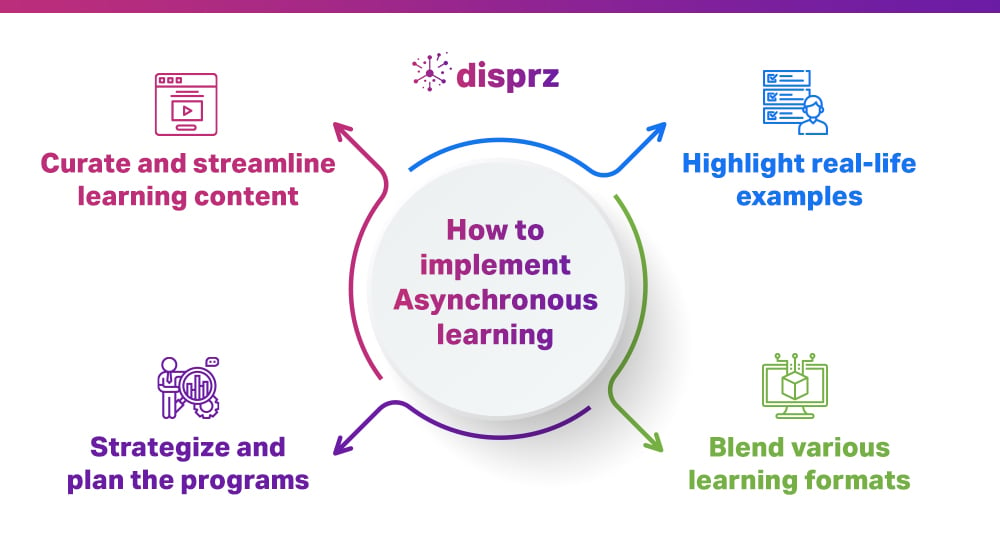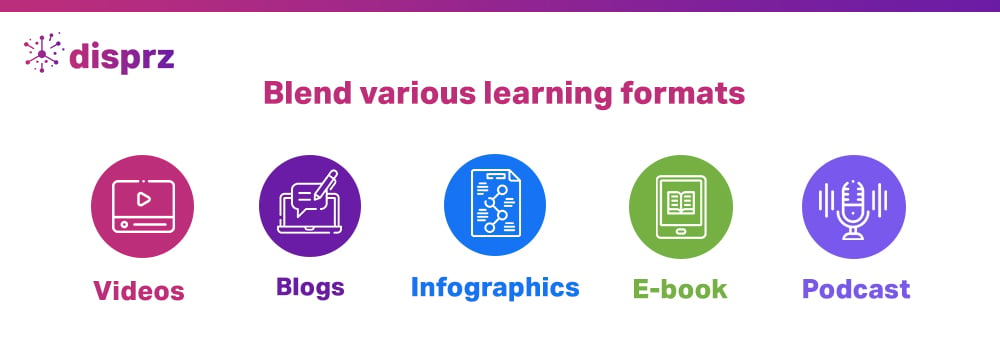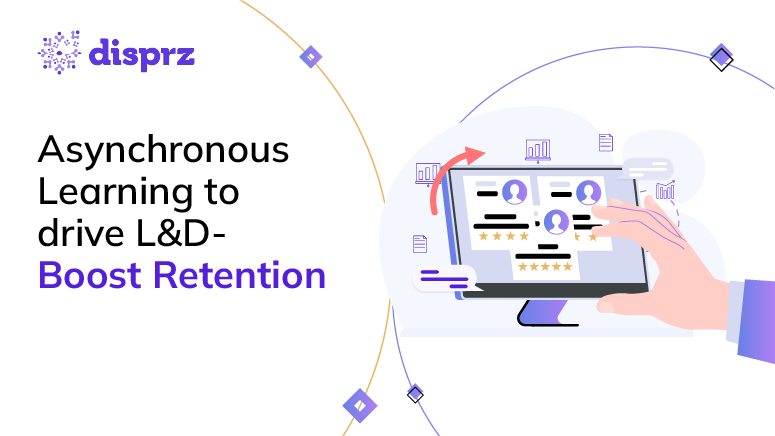The workforce today is demonstrating a strong desire for skill development. They constantly seek opportunities to grow and stand out in a competitive market. As per research, 77% of employees are ready to learn new skills
Employees are willing to expand their skillset but they do not have time to invest several hours in a conventional “in-person” training session. Employees need a more flexible approach, like asynchronous learning, that gives them the freedom to learn in the flow of work.
Let’s dive deeper to understand all aspects of asynchronous learning.
What is Asynchronous Learning?
Asynchronous learning is a learner-centered approach that facilitates self-paced learning by putting learning materials online rather than an instructor being present to deliver the training.
Learners have control over how, when, and where they want to learn. Employees don’t need to attend a training program at a specific time. They can learn at any hour of the day and complete the courses in a stipulated time frame. For instance, while commuting to the office or during coffee breaks, learners can learn something new to enhance their skills and get better at their job.
4 Types of Asynchronous Learning
There are various types of asynchronous learning. 4 of the most common types include:
1) Linear learning journey – The Learning & Development team creates a sequence of courses that the employees have to complete by the assigned due date.
2) Linear learning with hurdles – While doing these courses there are assessments in the middle to ensure employees understand the concept and then move ahead in the journey.
3) Full content access – Employees can explore and access anything from the content repository that interests them or help develop a particular skill.
4) Skill-based learning – Based on the proficiency level of an employee in a certain skill, courses are assigned to the employees.
Click Here to Discover the Difference Between Asynchronous Learning and Synchronous Learning
6 Benefits of Asynchronous Learning
Below are the key benefits of asynchronous learning that the L&D head can leverage to make learning a part of the employees’ work routine:
1) Employees can control the pace of learning
Not every employee learns at the same pace. Asynchronous learning gives employees autonomy to control the pace of their learning based on priorities, and individual capability levels
Employees can decide how, when, and where to learn. For instance, Samaira, an SEO executive, is assigned a two hour long video on how to conduct a website audit. She starts watching videos but receives an invite for an urgent call with the content team. So she can pause the video and continue later at her convenience during or even after work hours. She doesn’t need to learn at a stretch and keep her work commitment on hold.
2) A better understanding of learning concepts
Asynchronous learning isn’t only confined to disseminating new information. It gives employees opportunities to revisit the previously learned content multiple times until they fully grasp the concepts.
Moreover, in team training sessions or classroom modules, most employees aren’t comfortable voicing their doubts in front of the gregarious extroverts who often steal the spotlight. So, asynchronous learning gives such a workforce a platform to touch every point that’s unclear and ensure they gain full clarity over every concept that would add value to their performance.
3) Asynchronous learning is scalable
Asynchronous learning offers complete scalability to businesses. The L&D professionals can leverage the same training material and distribute it to a vast section of employees. They do not have to repeat generic training sessions when new members join. This helps in improving time to productivity and makes the new hire’s job ready quickly for being active contributors in driving business impact.
For instance, rather than conducting in-person compliance training on the same subject multiple times, L&D can create the content once and refine it in real-time. With the help of a learning platform, the L&D can easily design the learning programs, assign them to multiple employees and track the learning progress.
4) Promote learning on the go
Asynchronous learning seamlessly integrates into the flow of work. Learners don’t have to leave their work to jump into a long training session that makes them yawn. They can effortlessly balance learning with work when they can easily access L&D materials online.
Most learners find it challenging to retain all the information shared in several hours-long training sessions.
As per Udemy’s research, within one hour, employees forget an average of 50% of the information they just learned. Within 24 hours, that number surges to 70%. Moreover, within a week, it skyrockets to 90%.
Asynchronous learning not only ensures just-in-time learning but also enables employees to apply what they’ve learned to their work. This is a great way to combat the forgetting curve. So employees can absorb the information and implement it to work instantaneously.
5) Support in-person, hybrid, and remote work culture
Asynchronous learning doesn’t need to halt, no matter whether the employees are working from the office, remotely, or in a hybrid model. The L&D can provide consistent upskilling in all three work models as the location isn’t a roadblock in asynchronous learning.
It is crucial to introduce hybrid or remote employees with the right technology for asynchronous to be truly successful. So, they don’t have to rely on Google or other resources to amass information for learning new concepts and expanding their skillset.
As per research, 94% of employees would stay at a company longer if it invested in their career development.
Employees feel valued when companies show interest in their growth and are motivated to reciprocate with a great performance.
6) Opportunities for the L&D team to refine learning programs
The learning programs can get richer and more useful in an asynchronous environment. While in a synchronous environment, learning experiences are often finite and are limited to a single place. The L&D professionals are unable to make any tweaks once they deliver the training. While asynchronous learning offers ample room for improvement and growth. It can evolve over time through employees’ feedback to make the L&D programs stronger and better.
How to Implement Asynchronous Learning Online

The self-paced approach of asynchronous learning to learning succeeds in garnering attention due to the high level of flexibility it offers. However, to ensure its effectiveness, it should be implemented in the right way.
Below are a few tips for creating effective asynchronous learning
Curate and streamline learning content on one platform
Asynchronous learning gives employees the opportunities to sharpen their skillset and broaden their capabilities. However, we cannot deny the fact that time is a scarce resource. With fewer hours and more to do, employees wouldn’t spend their time toggling between various platforms for accessing learning materials.
As per research, 49% of employees claim they don’t have any spare time to prioritize their own learning.
It is surely overwhelming to shift through a large volume of information while managing work deadlines. Hence make the life of your employees easier by streamlining all the content on a single platform. So employees don’t have to keep an eye on their inbox for a learning resource or get distracted by a few video links on Messenger.
Below are a few ways to streamline content:
-
Determine the L&D budget for content development
-
Plan and create a centralized repository
-
Identify the resources from where you will curate the content
-
Determine how you will present the content to the learners
A learning experience platform can make your work easier and help you organize your learning content on one platform. A smart LXP even fetches the latest content from renowned resources and recommends it to your learners. Moreover, you can set email notifications to ensure the learners engage with the content in real time.
Strategize and plan the programs that need to be asynchronous
Synchronous learning is surely old school, but we cannot completely rule out this learning method and replace it with asynchronous learning. Some areas of training cannot be purely asynchronous; as instruction-led discussions have their own set of perks. So be extremely strategic about which learning programs can be asynchronous. Conduct a need analysis, create a master list of all your training programs, and set goals for each program.
Ask yourself of few questions while analyzing the master list and shortlisting programs that need to be asynchronous:
-
Will the learner fully understand this particular concept if taught asynchronously?
-
What will the employee gain if this program is taught synchronously?
-
Will the L&D goals be affected if this program is shared through a digital platform?
Highlight real-life examples and motivate employee
As we know, asynchronous happens completely digitally, so we need to give employees a strong motivation to ensure employees learn with unwavering determination. Therefore give them reasons for taking the online courses.
Here is how you can do it:
-
Help employees visualize the benefits of investing time in asynchronous learning.
-
Be clear with the objective and what they will gain by completing the course.
-
Be explicit about what skills they will develop by taking up a certain course and how that will impact their performance.
-
Instead of making L&D overwhelming by sharing a lot of theoretical knowledge. Make it interactive by sharing real-life stories of employees’ industry leaders and colleagues
Realistic scenarios are a great motivator that helps translate learning into real-time application at the workplace.
Blend various learning formats
Most of the time, employees enroll in a course but do not complete it. So it is crucial to make the asynchronous learning experience engaging. Experiment with various formats.

Find out which formats are getting the highest completion rate and merge them in a blended learning journey.
Amplify the blended learning experience with a perfect amalgamation of asynchronous and synchronous learning. The employees can understand the basic concept through digital learning, and later the instructor can dive deep into the concept to explain the technicalities in detail. The session can be recorded so that employees can go through the recorded video later to gain a better understanding of the concept.
Final thoughts
The asynchronous learning approach can be incredibly beneficial if used correctly with modern technology. As it is hosted digitally in the absence of the instructor, it is critical to use the right platform for delivering the learning programs.
A complete skilling suite like Disprz LXP can be a helping hand in establishing and nurturing an asynchronous learning culture. Disprz LXP isn’t just a basic training tool but a cutting-edge AI-powered skill-driven learning platform that caters to every stage of the employee’s lifecycle. This cloud-native white-labeled solution comes with enterprise-grade security and agile deployments tailored to your organization’s needs.
From skill-based learning to in-depth analytics, it is a complete solution to empower employees with the right skills. It is a win-win situation for employees and L&D professionals as employees can control their pace of learning and instructors can monitor employees’ learning progress and growth.









